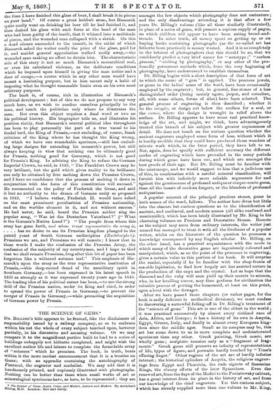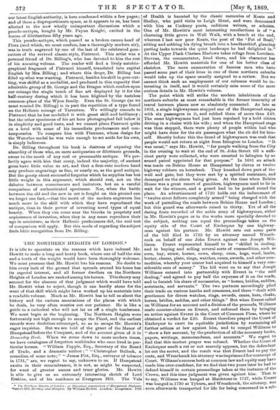THE SCIENCE OF GEMS.*
DR. BuLuia's title appears to be learned, like the disclaimers of responsibility issued by a railway company, so as to embrace within his net the whole of every subject touched upon, however partially, in his discursive and amusing volume. Or we may compare it to the magnificent portico built to lead to a series of buildings unhappily not hitherto completed, and might wish the excellent author life and leisure to complete the formidable array of "sciences" which he promises. The book, in truth, bears within it the more modest announcement that it is a treatise on Gems; with an appendix containing the autobiography of Pistrucci, the engraver and .medallist. We may add that it is handsomely printed, and copiously illustrated with photographs. .Nothing can be better than these when small works of art or mineralogical specimens have, as here, to be represented ; they are The Science of Gems, Jewels, Coins, and Modals, Ancient and Modern. By Archibald Billing, ALB. London : Bell and Deldx.
amongst the few objects which photography does not caricature ; and the only disadvantage attending it is that after a few years Dr. Billing's volume (like all those similarly illustrated), in place of a series of gems, will present a copious supply of pages, on which children will appear to have been eating bread-andtreacle. In sober truth, all money spent on gettiug up or on buying books containing photographs (as the so-called art has hitherto been practised) is money wasted. And it is so completely to the interest of photographers that this should be so, that we confidently predict a very brief career for "autotype ;" "carbon process," "etching by photography," or any other of the professedly permanent methods which, froiu the very beginning of photography, have eudeavoured to establish themselves.
Dr. Billing begins with a short description of that form of art to which the name of " gem " is applied. The precious jewels, or gems in the ladies' sense of the word, have been occasionally employed by the engraver ; but, in general, fine stones of a leas distinguished order (being mainly agate, jasper, and cornelian, all, with some others, forms of silex) have been selected. The general process of engraving is then described ; whether it be the intaglio, or design cut below the surface for a seal, or the cameo, where the design is wrought in relief above the surface. Dr. Billing appears to have some real practical knowledge of the art, and might, we think, have advantageously treated this branch of his subject with greater copiousness of detail. He does not touch on the curious question whether the ancient engravers employed some fcrm of lens, without which it is hardly credible that they could have produced those wonders of minute work which, in the later period, they have left to us. Nor, again, does he specify with sufficient accuracy the different modes of engraving which have prevailed in the mauy periods during which gems have been cut, and which are amongst the best proofs of their age. But Dr. Billiug must be familiar with the microscope, and we would suggest to him that a judicious use of this, in combination with a careful mineral classification, will furnish him with infinitely more reliable arguments for and against the genuineness of professed antique or cinque-conto gems, than all the boasts of modern forgers, or the blunders of professed antiquarians.
A popular account of the principal precious stones, gems in both Reuses of the word, follows. The author here dives but little into the obscure but curious questions as to the identification of ancient, and mediatval, and modern names (all alike confused and unscientific), which has been lately illustrated by Mr. King in his charming volumes on Precious and Decorative Stones. Remote as the subject may seem from ordinary interests, the writer just named has managed to treat it with all the liveliness of a popular writer, whilst on the literature of the question he possesses a knowledge unsurpassed by any English scholar. Dr. Billing, on the other hand, has a practical acquaintance with the mode in which many of the decorative gems are ingeniously coloured and manipulated, which, as on the point of the processes in engraving, gives a certain value to this portion of his book. It will surprise the reader, especially if he be familiar with the shop-fronts of sea-side lapidaries, to find how largely art has assisted nature in the production of the onyx and the crystal. Let us hope that the diamond and the ruby will soon yield up their secrets to science, who, in her levelling career, may then perform for civilization the valuable process of putting the housemaid, at least on this point, upon a level with the dowager.
After we have passed these chapters (or rather pages, for the book is sadly deficient in methodical divisions), we must confess to discovering a sorrowful falling-off in Dr. Billing's treatment of the "science of gems." This art is one of the oldest in the world ; it was practised successively by almost every civilized race of Asia, Africa, and Europe ; it has a history of its own in Assyria, Egypt, Greece, Italy, and finally in almost every European kingdom since the middle ages. Small as its compass may be, this art has come down to us in more complete and undeteriorated specimens than any other. Greek painting, Greek music, are wholly gone ; sculpture remains only as a "fragment of fragments." Greek gems still preserve an infinity of representations of life, types of figure, and portraits hardly touched by " Time's effacing Anger." Other regions of the art are of hardly inferior interest ; the historical cylinders of Assyria, the religious engravings from Egypt and Plicenicia, the rude signets of Sassanian
Kings, the clumsy efforts of the later Byzantines. Even the renewed art, from the days of the Medici to the Poniatowsky cabinet, has a great interest from its place in the history of Art, and from our knowledge of the chief engravers. Yet this curious subject, .which has already supplied more than one volume to Mx. King,
our latest English authority, is here condensed within a few pages ; and of these a disproportionate space, as it appears to us, has been allotted to the now wholly unimportant discussions which a pseudo-antique, bought by Mr. Payne Knight, excited in the bosom of dilettantism fifty years ago.
This pseudo-antique, which passed as a broken cameo head of Flora (and which, we must confess, has a thoroughly modern air), was in truth engraved by one of the last of the celebrated gem. cutters of the revived classic style, Pistrucci. This artist was a personal friend of Dr. Billing's, who has devoted to him the rest of his amusing volume. The reader will find a lively autobiographical fragment of Pistrucci himself, translated into capital English by Mrs. Billing ; and where this drops, Dr. Billing has filled up what was wanting. Pistrucci, besides his skill in gem-cutting, was skilful as a medallist, and produced in this capacity that admirable group of St. George and the Dragon which confers upon our coinage the single touch of fine art displayed by it for the half-century during which it has been blighted by the tasteless common-place of the Wyon family. Even the St. George (as we must remind Dr. Billing) is in part the repetition of a type found on the Hellenic coinage of Tarentum. We willingly concede to Pistrucci that he has modelled it with great skill and brilliancy ; but the other specimens of his art here photographed fall below it in simplicity and good taste, and we cannot place Pistrucci quite on a level with some of his immediate predecessors and contemporaries. To compare him with Flaxman, whose design for the Waterloo medal he was vain enough to set aside for his own, is simply ludicrous.
Dr. Billing throughout his book is desirous of exposing the absurdity of those who, on mere antiquarian or dilettante grounds, swear to the merit of any real or presumable antique. We perfectly agree with him that many, indeed the majority, of ancient gems have little value as art, and that a first-rate modern hand may produce engravings as fine, or nearly so, as the good antique. But the gossip about successful forgeries which he supplies has but little weight in this argument, which should rest, not on the debates between connoisseurs and imitators, but on a careful comparison of authenticated specimens. Nor, when the battle between the old and the new in art is fought on this ground can we forget one fact,—that the merit of the modern engravers lies much more in the skill with which they have reproduced the antique, than in their power of inventing novel types of equal beauty. When they can come near the Greeks in propriety and copiousness of invention, when they in any sense reproduce their age in miniature, as their Hellenic predecessors did, the real test of comparison will apply. But this mode of regarding the subject finds little recognition from Dr. Billing.































 Previous page
Previous page